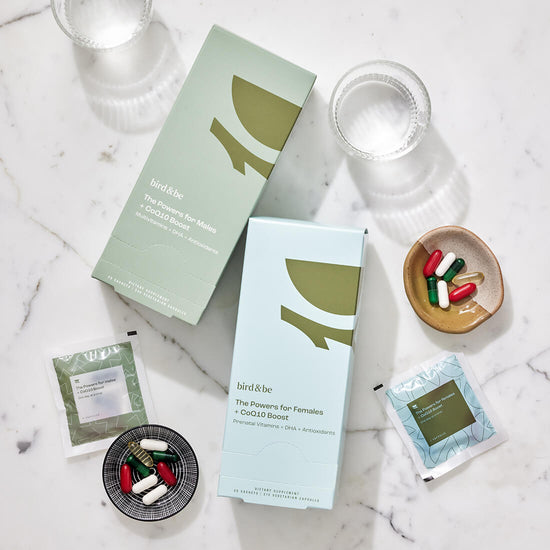Breaking down the ABCs of TTC
There’s so much to learn along a fertility journey, and sometimes just figuring out the lingo feels like a challenge all on its own. To help make your TTC journey easier to navigate—with every BFN, BFP, AF and TWW along the way—keep this fertility acronym decoder handy.
Tracking Your Cycle
2WW or TWW: Two-week wait. The time between ovulation and your expected period (which is when you can take a pregnancy test). A.K.A. the longest two weeks ever.
AF: Aunt Flow. That “monthly visitor” otherwise known as your period.
BBT: Basal body temperature. At-rest temperature, typically taken first thing in the morning. Because ovulation causes your BBT to rise, it can be used to help track your cycle.
BD: Baby dance. Having sex on your most fertile days in hopes of getting pregnant.
BFN: Big fat negative. A pregnancy test with a negative result.
BFP: Big fat positive. A pregnancy test with a positive result (meaning, pregnant!).
CD: Cycle day. The day number of your cycle. For example CD1 is the first day of your cycle (the day you start your period).
CM: Cervical mucus. The discharge you can monitor to help track when you’re going to ovulate.
DPO: Days past ovulation. The number of days since ovulation. For example, if you ovulate on a Monday, the Tuesday will be 1DPO.
EPT: Early pregnancy test. An at-home test taken before the end of the two-week wait. (Our Early Pregnancy Test, can detect hCG levels up to five days before your expected period).
EWCM: Egg-white cervical mucus. Clear, wet and stretchy cervical mucus (think: the texture of egg whites), which signals that ovulation is coming soon and it’s a good time to get it on if you’re trying to conceive via intercourse.
HPT: Home pregnancy test. A pregnancy test that you can do yourself at home via urine sample.
O: Ovulation. When a mature egg is released from the ovaries. This is when it can potentially meet with sperm in the fallopian tubes and be fertilized.
OPK or OPT: Ovulation predictor kit or ovulation predictor test. An at-home urine-based test that can help detect oncoming ovulation.
PG: Pregnant. Enough said!
POAS: Pee on a stick. An at-home pregnancy test done by, well, peeing on the testing stick.
TTC: Trying to conceive. When someone is actively trying to get pregnant.
Fertility Conditions and Treatments
AI: Artificial insemination. A broad term for fertility-treatment techniques where sperm is placed in the reproductive tract without sexual intercourse. IUI (intrauterine insemination) is one of the most common types of artificial insemination.
ART: Assisted reproductive technology. A broad term that covers different types of fertility treatments. IVF and ICSI are types of ART.
Beta: A pregnancy test that measures hCG (pregnancy hormones) in the blood. This is performed by a doctor, nurse or phlebotomist and is sometimes also called a quantitative test because it doesn’t just detect the presence of hCG but how much.
B/W: Bloodwork. Blood tests to measure hormone levels—a common part of fertility treatment.
DPR: Days past retrieval. The number of days since an egg retrieval (which is done for IVF and egg-freezing).
DPT: Days past transfer. The number of days since an embryo transfer in IVF treatment.
Endo: Endometriosis. A condition where endometrial tissue builds up outside the uterus, which can lead to irritation, scarring, severe pain and fertility problems.
ET: Embryo transfer. The transfer of one or more embryos (eggs that were fertilized via IVF) into a uterus. These embryos can be “fresh” (transferred a few days after the egg retrieval) or frozen (preserved by freezing).
FET: Frozen embryo transfer. The transfer of one or more frozen embryos (eggs that were fertilized via IVF) into a uterus.
ICSI: Intracytoplasmic sperm injection. A lab technique where an embryologist injects a single sperm directly into an egg to promote fertilization. (This is unlike conventional IVF where sperm and eggs are combined in a dish to fertilize on their own.)
IF: Infertility. Most commonly defined as being unable to conceive after one year of trying (but that doesn’t always mean you should wait that long to see a doctor).
IUI: Intrauterine insemination. A type of artificial insemination where sperm that has been collected and “washed” (a lab technique that separates out only the healthiest sperm) is placed directly in the uterus around the time of ovulation.
IVF: In-vitro fertilization. A type of fertility treatment where egg(s) are fertilized by sperm outside the body (in a lab). First, there’s an egg-retrieval surgery to collect mature eggs from the ovaries, and then later the embryo(s) are transferred to a uterus in hopes of implantation and pregnancy.
MF: Male factor. Infertility linked to issues with sperm.
PCOS: Polycystic ovary syndrome. A condition where people with eggs have higher-than-usual androgens (a.k.a. "male hormones"). People with PCOS may also have irregular periods and/or a surplus of follicles on their ovaries. (Follicles are the fluid-filled sacs that hold eggs—though not technically “cysts,” that’s where the name PCOS comes from.)
PIO: Progesterone in oil. The hormone progesterone, which supports the uterine lining and implantation, mixed with oil and administered by injection during some fertility treatments.
PUPO: Pregnant until proven otherwise. A positive mindset for the time between an embryo transfer and pregnancy test.
RPL: Recurrent pregnancy loss. Two or more consecutive pregnancy losses.
SI: Secondary infertility. Struggling to conceive or carry a pregnancy to term after already giving birth to at least one child.
US: Ultrasound. An imaging method that allows medical professionals to look at ovaries, the uterus, a developing fetus and more.
Fertility Doctors
ND: Naturopathic doctor. A doctors who specializes in naturopathic medicine, which typically combines scientific approaches with traditional and natural remedies.
OB or OB/GYN: Obstetrician or obstetrician-gynecologist. While a gynecologist focuses on female reproductive health overall, an obstetrician specializes in preconception, pregnancy, childbirth and post-natal care.
RE: Reproductive endocrinologist. A doctor who is board-certified in reproductive endocrinology and infertility (REI), meaning they specifically help patients become and stay pregnant.
Hormones
FSH: Follicle-stimulating hormone. A hormone that promotes the development of eggs and sperm.
hCG: Human Chorionic Gonadotropin. A hormone produced by a developing placenta, which can be measured in urine or blood tests to detect pregnancy.
LH: Luteinizing hormone. A hormone that triggers ovulation in people with eggs and stimulates testosterone production in people with sperm.




